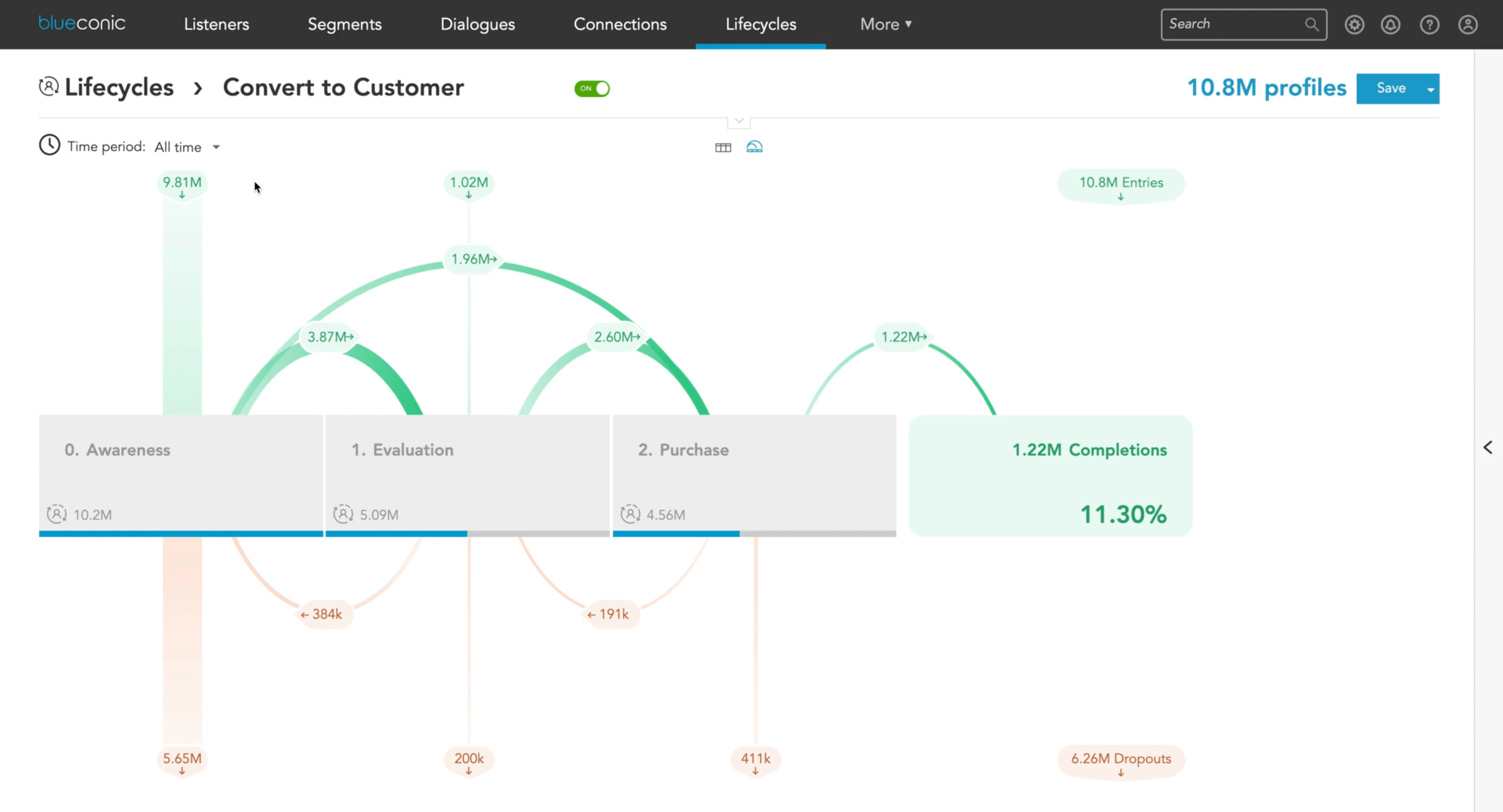The success of many companies’ marketing strategies (and, in turn, their growth strategies) today is still too dependent on the success of their static, outbound campaigns.
The problem with campaigns is their rigid, rules-based workflows prevent real-time personalization to customers based on their most recent activity and attributes.
There’s certainly a time and place for organizations across industries to execute integrated campaigns (e.g., promote new products or services, offer special subscription discounts).
But many companies, including those that use BlueConic, have prioritized customer lifecycle marketing — and ongoing customer lifecycle management — instead to better understand and engage their customer base and realize better marketing and business outcomes.
Customer lifecycle management: What it entails — and why it’s so important
As we’ve explained, customer lifecycle orchestration is the next frontier of marketing.
“[W]e’ve gone beyond personalization being ‘including your name in an email’ to providing the right experience dependent on who you are, what your preferences are, and where you are in a customer lifecycle,” BlueConic Director of Product Marketing Sam Ngo noted.
Companies use the approach to move prospects and customers through sequential, mutually exclusive lifecycle stages that share a common goal (e.g., influence individuals to buy for the first time, purchase again, subscribe to a service, and/or join a loyalty program) based on first-party data they have for them in their tech and data ecosystem.
This modern customer engagement approach helps businesses more sustainably grow revenue. Just as important, though, it also benefits their growth teams in three distinct ways:
Teams that own and execute lifecycle strategies can streamline their business processes (e.g., automate much of their marketing), move away from (or reduce reliance on) the campaign-centric approach, and become more customer-centric.
Those same teams can provide more bespoke customer experiences and build better customer relationships, thanks to providing timely and relevant messaging to individuals as they move through their respective customer journeys.
All teams — not just analytics — can more capably and efficiently decipher interactions, attributes, and behaviors by evaluating dynamically updated data for each stage of the customer lifecycle (i.e., as customers move from stage to stage) and adjust their engagement efforts accordingly.
It’s this last area — routinely analyze and optimize their lifecycle marketing — that is critical for companies to master to ensure their orchestration strategies deliver the desired ROI.
Enter customer lifecycle management: the ongoing measurement and assessment of lifecycle-related activity on the channels and touchpoints on which customers engage.
The formula for successful lifecycle management is simple. Your business must:
Ensure growth teams who orchestrate lifecycle marketing activities (often marketing, but not always) have the right tech to execute their strategies (more on this shortly)
Agree upon the core success metrics to track and aim to improve over time
“The metrics framework needs to ensure that metrics at the more granular level are able to support the business teams and help them improve their key success metrics,” analytics expert Weiwei Hu recently wrote for Towards Data Science, regarding customer lifecycle analytics and reporting.
In other words, companies must ensure improvements to tactical metrics (e.g., customer retention, customer lifetime value) contribute to improvements to their strategic metrics (i.e., revenue, growth-focused teams’ operational efficiency).
The only way they can accomplish this is with a well-thought-out customer lifecycle management strategy — and a customer data platform (CDP) that offers lifecycle orchestration capabilities and related, real-time insights to business users.

How companies use BlueConic to manage and report on their lifecycle strategies
The Lifecycles set up by BlueConic customers differ based on a variety of factors, including their niche industries, business models, target audiences, and strategic ambitions.
But these businesses’ approach to customer lifecycle management is mostly the same.
Whether it’s retailers looking to cross-sell high-frequency shoppers or publishers aiming to grow the renewal rate for premium-content subscribers, organizations of all kinds use Lifecycle reporting in BlueConic to better track their engagement strategies’ performance and use those insights to refine them over time.
Three ways BlueConic customers can make the most of Lifecycles reporting are by:
Comparing the performance of multiple Lifecycles (i.e., ones with different objectives) to gauge which lead to the most conversions (and, therefore, are perhaps worth emulating in terms of structure for poorer-performing Lifecycles)
Assessing how each individual Lifecycle performs in different periods (e.g., analyzing progressions, drops, dropouts, and completions over the last 30 and 90 days) to see if changes made to each Lifecycle (i.e., touchpoints and/or thresholds added and/or removed) affected performance positively or negatively
Identifying any Lifecycle stages that may be redundant or unnecessary (i.e., most individuals included in the Lifecycle skip that stage altogether to move to another stage or even complete the Lifecycle) so as to optimize the Lifecycle in question
(Learn more about the technical details of Lifecycles reporting on our Knowledge Base.)

With regular check-ins on this reporting page — which updates as individuals interact with each touchpoint (e.g., engagement with individualized emails, on-site dialogues, and/or social media ads) assigned to each lifecycle stage — BlueConic customers can see how their engagement efforts impact team-centric metrics and their companies’ bottom lines.
The approach to Lifecycle configuration will vary from business to business:
An international retailer with a few million customer profiles in BlueConic may have a handful of different Lifecycles (i.e., ones for retention, churn prevention, upselling, etc.). Each Lifecycle could feature hundreds of thousands of individuals at any given time.
A regional publisher with just 50,000 customer profiles, meanwhile, may just have a single Lifecycle set up to encourage subscription sign-ups to non-subscribers.
Thus, the tracking and reporting complexity will differ for both businesses. All this is to say: No two organizations’ lifecycle marketing approaches will look or be managed the same.
But the next-level reporting in Lifecycles offers invaluable insights for all companies with BlueConic — regardless of the industry, business model, or number of customer profiles.
More specifically, it simplifies customer lifecycle management for their marketing, CX, commerce, customer service, digital product, analytics, and other growth-focused teams.
And when these teams are able to report on their lifecycle marketing successes (e.g., specific improvements to key programs and core tactical metrics) to their managers and organizational leaders — just as they do with their integrated campaigns — they can make a clear and compelling case to fully transition to (or, at least, mostly prioritize) lifecycle orchestration as their primary customer engagement approach.
Lifecycles reporting: A fundamental facet of modern customer lifecycle marketing
There are a few key tasks BlueConic customers must tackle before they should focus on managing and reporting on those custom-tailored engagement strategies. Notably:
Determine their specific organizational objectives for leveraging Lifecycles (and factor in their respective customer data platform use case roadmaps)
Design their initial Lifecycle(s) and decide on stages to include in each one
Develop processes around Lifecycle ownership, execution, and optimization (i.e., which team(s) will be involved in the setup and ongoing modifications for Lifecycles)
Suffice to say, customer lifecycle management is their key to modernizing their customer relationship management, and advancing their data-driven marketing strategies
This transition to and embrace of customer lifecycle marketing and subsequent reporting doesn’t just mean greater profitability and more educated decision-making for businesses.
It also means more efficient, scalable operations for each growth-focused team.
As BlueConic COO Cory Munchbach told CMSWire, “[C]hanging from the traditional marketing calendar to personalized messaging sent in response to individual customers’ signals within each [lifecycle] phase means shifting to a wholly different way of working.”
This new way of working doesn’t just refer to a smarter customer engagement model.
It also means more streamlined analysis and data-driven optimization for all technology users — changes that can lead to smarter marketing and better business outcomes.
Watch our webinar to learn how companies across industries use BlueConic to implement customer lifecycle marketing strategies that help them unleash business growth.






